In the ever-evolving landscape of the gaming industry, certain titles emerge from obscurity to capture the imagination of players worldwide, often for unforeseen reasons. One such phenomenon has recently emerged in the form of “Piglet’s Big Game.” Featuring the beloved character from the Winnie the Pooh franchise, this unexpected entry has taken a unique approach to the platform, intertwining elements of horror with what is traditionally considered child-friendly content. As its resemblance to iconic horror titles such as Resident Evil and Silent Hill came into focus, the game transformed into a viral sensation across social media platforms, stirring discussions about its innovative gameplay mechanics and thematic boldness.
What makes “Piglet’s Big Game” stand out in a crowded marketplace of children’s games is its underlying concept designed for a young audience while still invoking a sense of unease. Pascal Stradella, the former studio director at Doki Denki, shared insight into the development philosophy that guided the creation of this unconventional title. According to him, the objective was never to instill genuine fear in players but rather to evoke a sense of discomfort and anxiety. Stradella describes the game as a horror-comedy, providing just enough tension to keep players on edge while balancing it with lighthearted moments intended to elicit laughter.
This distinctive approach blends horror tropes with a comedic narrative, setting a precedent within the genre. Instead of relying on grotesque imagery or graphic content, the game utilizes sound design to build suspense, creating an atmosphere where children can experience thrill without crossing the line into trauma. This nuanced understanding of the young audience’s limits in gaming is what imbues “Piglet’s Big Game” with its charm and innovative quality.
The gameplay mechanics also echo this philosophical stance. The introduction of a ‘state’ bar system in place of traditional health points allows players to navigate Piglet through various emotional states: from ‘Normal’ to ‘Worried’ and finally to ‘Panic.’ This innovative feature not only fosters a unique emotional connection to the character but encourages strategic gameplay as players must seek ‘life fountains’ to restore balance.
As players explore the haunting realms of the game, they are prompted to confront Piglet’s fears, which can lead to moments of genuine tension. However, it isn’t all doom and gloom; the developers have cleverly injected comedic relief where needed, ensuring that the gameplay experience remains accessible and enjoyable for younger audiences.
The amount of intrigue surrounding “Piglet’s Big Game” has fueled a recent surge in demand, with rare copies selling for exorbitant prices online. This overwhelming response highlights not just the game’s unique conceptual framework but also the nostalgia associated with characters like Piglet. The fusion of horror and comedy in a child-focused narrative has opened up important conversations about the boundaries of children’s gaming, showing that even a character as innocent as Piglet can be placed in surprisingly complex scenarios.
“Piglet’s Big Game” stands as an emblem of creativity within the gaming industry, challenging norms and expectations. As such, its development process serves as an inspiring example for future titles, redefining the limits of what children’s games can explore, and potentially paving the way for a new genre that embraces both fear and laughter in playful harmony.


Leave a Reply